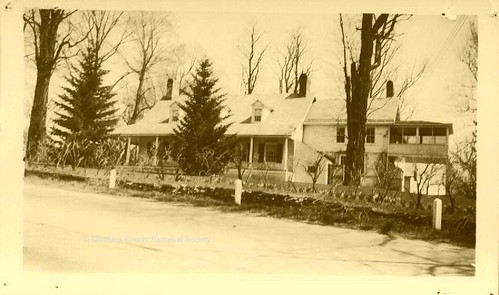The Fort Homestead
July 15, 2010 by admin
The Abraham Fort Homestead is a historic house built on property that is now the Casperkill Country Club. The Homestead, which is built in a style characteristic of the Revolutionary war period—made of stone and brick, longer than it is broad, a story and a half high, and a hall through the center of the house—was saved from demolition in May of 2004.
In her book Poughkeepsie: The Origin and Meaning of the Word, Helen Wilkinson Reynolds writes that the land the Fort Homestead stands on was sold by Christopher VanBommel to Johannes Abraham Fort in 1759, and that the homestead was “built either by the VanBommel Family between 1742 and 1759 or by Johannes A. Fort in about 1760.” (1) Johannes A. Fort’s son, Abraham Fort, was a well-known Lieutenant in the Revolutionary war, and he succeeded his father in the house. It is rumored that General George Washington slept in the house while Abraham Fort had the title to the property. Following the Revolutionary war, several generations of Forts lived in the family estate; many of them are buried in a cemetery across Route 9 on South Gate Drive.
From the late 1700s through the early 1900s, the Fort Homestead property changed hands many times. In 1911, Frank Dickerson Sr. bought the Fort property. Because Dickerson owned a large tract of land adjacent to the homestead land, the purchase brought his total landholdings to 300 acres. Frank Dickerson Jr. later wrote out a guided tour for the Fort Homestead (2). In this piece he discusses some of the things he remembers about the Casperkill as it flowed by the Homestead:
Down the lane, past the chicken coops and the smoke house, [is the] the bridge over Casper Creek. The water is low now but in spring run-off the stream may be plugged with ice and over-flow the bridge. It’s a dangerous roaring torrent then. I love this creek (it’s also called the Kasper Kill) and like to swim in it on a hot day. I used to fish it, but when a cart full of lime overturned at the next farm upstream, it killed off all the trout. There still are a couple of them in the spring at the foot of reservoir hill. Maybe they will come back in the creek.”
In 1944, when the Dickerson family sold their 300 acres to IBM, the Casperkill was affected in new, even more severe ways. IBM bought the land “for extension of the Country club and Post-war housing for IBM employees,”(3) and the acquisition brought the company’s total holdings in Poughkeepsie to 638 acres (a month later this number increased to 855 acres when IBM bought the Kenyon Estate, “Cliffdale,” two miles south of Vassar College). (4)
In a return visit to Poughkeepsie in 1994, Frank Dickerson Jr. wrote about the effect that IBM, and the suburbanization of Poughkeepsie, had on the Homestead property and the surrounding South Road area:
I returned to find that the South Road had become a six-lane highway, Route 9. It encroached on the house and the traffic noise was so bad that the owner (of the Fort Homestead) had erected a ten-foot stockade fence as a barrier…All of the out-buildings on both farms were gone, and the land had been cleared for a poorly maintained golf course. Even hills had been changed for the convenience of the golfers. The orchards and back woods are now a development of split-level ranch houses built on speculation. My nostalgia deepens as I grieve.”
In 2004, The Fort Homestead Association formed to prevent further damage from occurring. Early in that year the Ginsberg Development Corporation, which had been hired by the Casperkill Country Club to develop the Homestead property, decided that they wanted to demolish the historic Homestead. After hundreds of local residents spoke out against the demolition, the Fort Homestead was saved and added to Town of Poughkeepsie’s historic landmark registry. A reporter quoted local resident Meredith Sawyer, who said that the Fort Homestead was one of many “beautiful jewels to preserve” in the Route 9 area. The reporter went on to emphasize that preservation efforts like the one being undertaken by the Fort Homestead Association are essential in order to “help neighborhood residents realize that [the area] has more to offer than just strip malls and traffic.” (5)
For more information about the Fort Homestead and to get involved in restoration efforts, please visit the Fort Homestead Association’s website. You can also visit their facebook page to view more pictures of the historic house.
Information from:
(1) Reynolds, Helen Wilkinson. Poughkeepsie: The Origin and Meaning of the Word, Volume 1. Poughkeepsie, NY: Collections of the Dutchess County Historical Society, 1924.
(2) Information about, and quotes from, Frank S Dickerson Jr.’s “the Farm” are from personal communication with Judy Wolf, president of the Fort Homestead Association. For more information about Frank S. Dickerson Jr.’s writings or to purchase “Consider the Angels,” a compilation of his poetry, please click here.
(3) “IBM Buys 300-acre Dickerson Tract; Housing, Club Extension Projected.” Poughkeepsie New Yorker 2 June 1944.
(4) “IBM Buys Kenyon Estate, ‘Cliffdale’.” Poughkeepsie New Yorker 1 July 1944.
(5) MacFarland, Ian. “Town Grants Historic Status.” The Weekly Beat [Poughkeepsie] 9 July 2004.
Image from:
The Dutchess County Historical Society. Image #2002024005, Box #30.
Special thanks to Judy Wolf and Ginny Buechele for all of their help!!

Wonderful Blog – Keep up the Great Work
“As we make improvements, we should remember the fundamental things that we know are good, and weld the good of the old order and the good of the new order.”
Thomas J. Watson, Founder – IBM [IBM “Colonial House” Brochure]
In the day when IBM owned the Homestead and for some years thereafter, what we know today as the Fort Homestead was known as “Colonial House”.